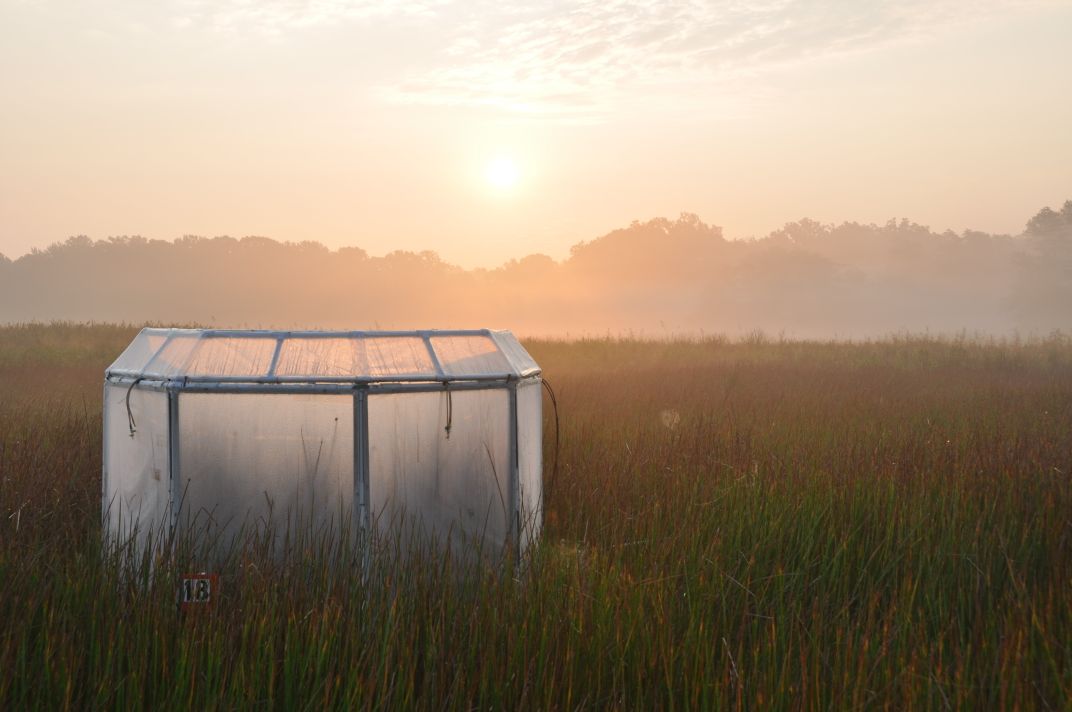Marshes Grow Stronger When Faced With Increased Carbon Dioxide
Marsh plants respond to increased CO2 by growing many small stems, creating a denser wetland that may protect against sea level rise
:focal(1127x741:1128x742)/https://tf-cmsv2-smithsonianmag-media.s3.amazonaws.com/filer/e0/5a/e05a2553-58d1-4fcb-b3b5-59423cae4de1/gcrew_from_water.jpg)
Carbon dioxide is textbook plant food. Plants take in carbon dioxide (CO2) and release oxygen, so it’s no surprise that increased CO2 emissions have a steroid-like effect on the world’s flora. However, plants have to take in a balanced diet of carbon dioxide, nitrogen and other nutrients to grow big and tall. The result of a CO2-heavy diet, scientists found, can be an unusual pattern of growth.
A team of researchers at the Smithsonian Environmental Research Center (SERC) working in a marshland on the Rhode River in Edgewater, Maryland, recently took a closer look at how high levels of CO2 affect marsh plant growth. They knew that carbon dioxide has a positive effect on the overall biomass of marsh plants and assumed that individual plants must be producing bigger stems. But the results of the study, recently published in Nature Climate Change, actually showed plants producing smaller but more plentiful stems.
“I don't think anybody expected this,” lead author Meng Lu says in a press release. “Everyone thought, okay, [plants] increased, biomass increased, so the height, width, all should increase. But that’s not the case in a marsh.”
Lu and his team worked in the Global Change Research Wetland (GCRW) at SERC, where scientists have been experimenting with CO2 enrichment since 1987. Based on three decades of data, they found that the total biomass of marsh sedges growing in high-carbon dioxide chambers increased by 20 percent, but the biomass of individual stems shrunk 16 percent.
This “shrinking stem” effect is caused by a relative lack of nitrogen compared to increased carbon dioxide. “There's plenty of nitrogen in the tidal wetlands, but when the plants are growing under elevated CO2, they actually can grow faster and therefore they need more of that critical nutrient nitrogen to grow,” says Patrick Megonigal, a co-author of the study who runs the GCRW.
When plants are nitrogen-limited, they respond by spreading their roots deeper into the ground to seek more nutrients from the soil. Keryn Gedan, an assistant professor of biology at the George Washington University who is not associated with the study, says this response is typical for many types of plants. But for clonal plants like marsh sedges, root growth is inherently linked to the formation of stems above ground.
“What's unique about clonal plants is that as they build their below-ground biomass—sending out these foraging roots and rhizomes—they're automatically building new stems too, because that's how clonal plants spread and grow,” Gedan says.
Although clonal plants with limited nitrogen resources continue to grow new stems above ground, these stems are shorter and skinnier due to the nutrient deficiency. In the elevated carbon dioxide scenario, researchers found that stem height shrunk five percent and diameter declined ten percent. The team also conducted a second experiment where they increased carbon dioxide and nitrogen, finding that the shrinking stem effect disappeared when both nutrients were available in abundance.

However, there seems to be a trade-off between root growth and shoot growth. The plants in the second experiment grew taller stems and had a greater above-ground biomass, but their root productivity declined by 15 percent compared to the carbon dioxide-dominant scenario. The denser roots associated with elevated carbon dioxide allow the marsh to build more soil, which gives wetlands a fighting chance in the face of sea level rise.
“The wetlands of today will be able to survive a higher rate of sea level rise than the wetlands of yesteryear,” Megonigal says. “While the rates of sea level rise are accelerating, there are mechanisms by which these ecosystems with their plants and microbes might be able to increase their rate of elevation gain.”
The density and size of aboveground stems can also affect elevation gain in marshes. “Elevation gain happens through two mechanisms: sediment particles can stick to the plant itself, or the main way is that plants slow down the flow of water, letting the particles settle more,” says Simon Mudd, a professor of earth surface processes at the University of Edinburgh who is not associated with the study. While thin stems are usually less effective at trapping sediment, having a high density of stems counteracts the loss in diameter.
Mudd describes the effect of carbon dioxide on stem growth as a negative feedback loop: as sea levels rise due to climate change, marsh plants get better at trapping sediment and contribute to elevation gain. In a world where sea level is rising, this protective mechanism is vital to the cause of preserving wetland ecosystems and providing a buffer for the coastline in the face of natural disasters.
Not only do coastal wetlands absorb energy from superstorms and hurricanes, but Megonigal says they also keep some carbon and pollutants out of the atmosphere by storing them in their soil. For the relatively small fraction of the Earth they cover, he says these ecosystems are doing “more than their fair share” of climate mitigation. While marshes alone are not enough to solve climate change, their resilience gives reason for some optimism.
/https://tf-cmsv2-smithsonianmag-media.s3.amazonaws.com/accounts/headshot/Daily-Staff-Photos-by-Noah-Frick-Alofs-3620-317x475.jpg)
/https://tf-cmsv2-smithsonianmag-media.s3.amazonaws.com/accounts/headshot/Daily-Staff-Photos-by-Noah-Frick-Alofs-3620-317x475.jpg)